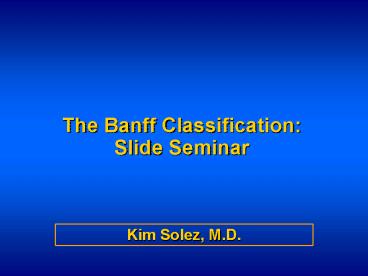The Banff Classification: Slide Seminar - PowerPoint PPT Presentation
1 / 22
Title:
The Banff Classification: Slide Seminar
Description:
The Banff Schema was first developed by a. group of ... vascular changes: endothelial reactive changes, vacuolization, venulitis. Acute Tubular Injury ... – PowerPoint PPT presentation
Number of Views:103
Avg rating:3.0/5.0
Title: The Banff Classification: Slide Seminar
1
The Banff Classification Slide Seminar
- Kim Solez, M.D.
2
The Banff Schema was first developed by a group
of pathologists, nephrologists, and transplant
surgeons at a meeting in Banff Canada August
2-4, 1991.
The Banff Schema was first developed by a group
of pathologists, nephrologists, and transplant
surgeons at a meeting in Banff Canada August
2-4, 1991.
It has continued to evolve through meetings
every two years and has become the worldwide
standard for interpretation of transplant
biopsies.
3
Banff Classification Milestones
- 1991 First Conference
- 1993 First Kidney International publication
- 1995 Integration with CADI - identical scoring
- 1997 Integration with CCTT classification
- 1999 Second KI paper. Clinical practice
guidelines. Implantation biopsies, microwave. - 2001 Classification of antibody-mediated
rejection - Regulatory agencies participating
4
(No Transcript)
5
(No Transcript)
6
(No Transcript)
7
(No Transcript)
8
Quantitative Criteria for Arteriolar Hyaline
Thickening
- 0 No PAS-positive hyaline thickening
- 1 Mild-to-moderate PAS-positive hyaline
thickening in at least one arteriole - 2 Moderate-to-severe PAS-positive hyaline
thickening in more than one arteriole - 3 Severe PAS-positive hyaline thickening in
many arterioles
9
Changes not considered to be due to rejection
- Post-transplant lymphoproliferative disorder
- Non-specific changes
- focal interstitial inflammation without
tubulitis Nodular infiltrates, perivascular
infiltrates - vascular changes endothelial reactive changes,
vacuolization, venulitis. - Acute Tubular Injury
- Acute Interstitial Nephritis
- Cyclosporine-associated changes, acute or chronic
- Subcapsular Injury
- Pre-transplant Acute Endothelial Injury
- Papillary Necrosis
- De novo Glomerulonephritis
- Recurrent Disease
- Pre-existing Disease
- Other-viral infection (CMV), obstruction and
reflux
10
(No Transcript)
11
Specimen Adequacy (Banff 97) Minimum Sampling
- Unsatisfactory No glomeruli or arteries
- Marginal 7 glomeruli with an artery
- Adequate 10 or more glomeruli with at least two
arteries - Minimum Sampling 7 slides 3 HE, 3 PAS or
silver stains, and 1 trichrome
12
Standardization of tx biopsy interpretation.
Banff Classification
- Classification begun at 1991
- Banff meeting has become the worldwide standard
- Consensus process has now extended to all solid
organs - Meetings continue every two years. Next meeting
in Edmonton in summer of 2005 - Future meetings planned every two years through
2009 - Standardization principles now being extended
from biopsy reporting to tissue typing, imaging,
all the other elements in transplant care
13
Standardization of tx biopsy interpretation.
Banff Classification
- Lesion quantitation
- Reproducibility and clinical validation studies
- Involvement of pathologists, clinicians,
surgeons, scientists, registries, and regulatory
agencies in consensus generation - Meetings have large amount of unstructured time
for deliberation and consensus generation - Most content online at http//cnserver0.nkf.med.u
alberta.ca/Banff - Linked from http//www.cybernephrology.org
14
(No Transcript)
15
(No Transcript)
16
(No Transcript)
17
Agreed upon clinical practice guidelines that
need buy-in generally
- Implantation biopsies
- Rapid paraffin (microwave) processing for rapid
reading rather than frozen sections - Routine (protocol) biopsies
- HE, PAS (/o silver), and trichrome or Sirius
red stains
18
Perioperative (implantation) Biopsy
- Core vs wedge
- Adequacy of sample
- Preimplantation vs. postimplantation
- Consensus
- Perioperative biopsy (? core, ? wedge) is
sufficiently safe to be recommended for any
reasonable defined objective - STANDARD OF CARE!
19
Protocol (routine) biopsies
- Early and intermediate post-transplant protocol
biopsies - Consensus
- Generally done under ultrasound guidance
- Have very low morbidity
- Safe enough to be requested of consenting
patients for research purposes when the
objectives are clearly formulated and stated - STANDARD OF SCIENCE!
20
Future Banff Meetings
- 2005 - Edmonton, Alberta, Canada
- 2007 - Edinburgh, Scotland
- 2009 - Banff, Alberta, Canada
21
Close
- Banff 97 Classification is the new universal
classification of kidney transplant pathology - Future improvements involve participation in
Banff meetings via physical presence or
contributions via Internet
22
Subscribe to free Nephrol Email groupBecome
part of the ongoing discussions
- To subscribe send an E-mail message to
majordomo_at_ualberta.ca with the message subscribe
Nephrol
(or Nephrol-digest) - Or contact Kim.Solez_at_UAlberta.ca or
Michele.Hales_at_UAlberta.ca































